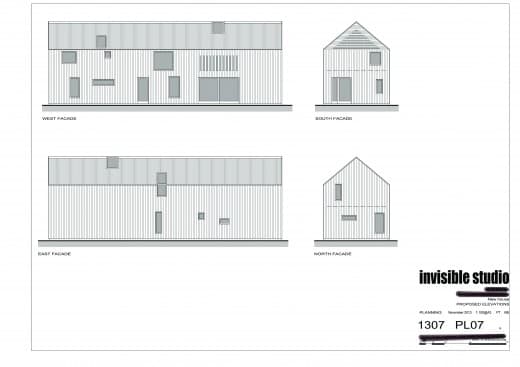So, today, we’ve reached a new nadir in the life of a practice already used to the ups and downs of dealing with provincial planning officers. We are rumoured, after all, to have told one case officer who, on insisting that an eclectic suburban street could only take a ‘traditional’ building that this was an astonishing case of cultural conservatism, and, well, as this was 2014, he needed to get out a bit more. We duly got that consent, and we’d been lulled in to the false sense of security that case officers liked a bit of straight talking.
But, now, we’ve also been saved a bit of work. We have an application running for a new house in rural UK, in a nondescript street, in an ordinary village, and the application has gone beyond the date for determination as the scheme is proving too challenging for the local authority. They have refused to determine the application. The scheme is a pretty modest, low cost, extremely simple, black timber clad long house.
This morning, we’ve learnt that the case officer has taken the matter in to his own hands by, unprompted by us, taking our scheme, and drawing his preferred scheme over the top – complete with suburban developer spec bell render pebbledash gable ends, lean to porch, and re arranged render. He’s also taken the liberty of leaving our title block on, and resubmitted the drawing to himself, and is planning to favourably determine the application. This is, let’s remember, without any contact with us. We’re yet to track him down, and we’ve left a message for him to call. We’re looking forward to catching up with him.
We’re also wondering whether, in the age when everyone is an expert on design, all councils can offer a one stop shop and do the application drawings AND the determination, and architects can simply disappear further to the margins…
 Above: Our original drawing. Below: The Local Authority’s version.
Above: Our original drawing. Below: The Local Authority’s version.

4 Comments
This is ridiculous. Were you given any feedback at all or did this just come out of the blue?
Piers,
I don’t think you have anything to worry about……………………….what a hideous redrawing. It looks as though someone has vomited the contents of a DIY Superstore onto the side of your building.
He’s obviously drawn the porch on the side so he has somewhere to stand whilst you tell him to fuck off.
Staggering arrogance.
The new north facade looks like a child has drawn it…
Not the new work experience planner is it..???
And I would politely suggest they are in breach of copyright to the head of planning and wait for the response !
I’m a bit late seeing this one, but its not surprising at all.
Our approach to the built environment in this country is laughable. Something seemed to go wrong in the post war period. We are trapped inside a distopian vernacular pastiche. A horrific risk averse architecture of mock Tudor, mock Victorian, mock vernacular cottage with UPVC Windows, with satellite dishes and fibreglass chimney units craned in and screwed into place.
What is responsible for this state of our environment? My guess is the “profession” of planning. Up until recently ALL planners generally where either Geography or some other non architecture degree who then take a 1 year course in becoming a planner.
Compare that to the cumulative education of the Architect sitting across from them. Probably a innate aesthetic inclination X Years experience, creative/practical GCSE’s 2 Years, creative/practical A-Levels 2 Years, Architecture Degree PART 1-3 Min 7 Years (put usually more).
So the situation is the planner has generally less than 1 years experience of the disciplines involved straight out of the gate versus the Architects in excess of 11 years. But yet the planner holds the whip hand. How is this a rationale power dynamic? In any other walk of life the individual assessing the merit/value of something HAS to have superior experience OR qualification.
Isn’t the Planner/Architect power balance more akin to a final year student at the Royal College of Art being given a crit by a child that has just mastered finger painting?
On top of this, Architecture is not a protected profession. In other aspects of life for example Plumbing, Dentistry, Medicine etc etc. A specific standard of experience or skill is required for delivering that skill to a client. In architecture, anybody with a set square & a pencil can have a go. Transfer this limited expectation of skill too the above professions. Man off the street: “Yeah, i’ve got a pair of pliers I will sort your teeth out….”
I worked out a few years ago what RIBA takes in each year just on membership fees (if memory serves it was around the 10 million mark) not including monies made from other commercial activity/contract sales etc. And yet they don’t use this money to lobby for protection of the profession or attempting to limit the corruption of the built environment by Planners or the volume house builders?
With a situation like this its not surprising the high suicide rate of Architects.
Sorry if this seems a bit rabid.
P.S.
I was talking with the head of planning in a large National Park in England.
I asked him: “What are the best parts in your view of the built environment in X historic market town?” He pointed out a speculative development of Georgian town houses & some Victorian workers terraces…. I agreed with him. I then asked, “And what are the best things since 1950?” (when the park was formed) he was silent for ten seconds and said “errrrr, well, its not as simple as that” The conversation ended. You’ve got to love those planners.